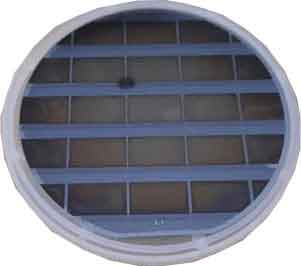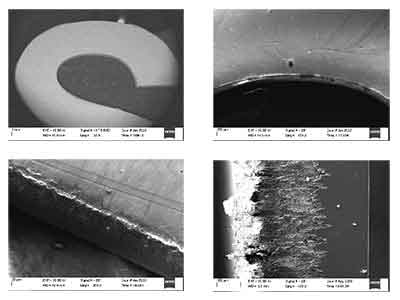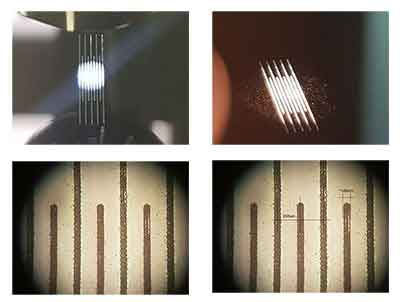I wanted to inquire about diced Si wafers; I noted item ID# 3901 on your website, which was a 6x6-mm square SSP wafer, unfortunately, our intended use has an upper limit of 5-mm, which precludes our use of that specific item. I’d like to get a price estimate for: 100 SSP wafers (~500-μm thickness) with any resistance which are 5x5-mm in dimension. 100 ITO glass slides (~0.55-mm thickness) with any resistance which are 5x5-mm in dimension.
Diced Silicon Wafers Small Quantities Available
Diced Silicon Wafers
Dicing silicon wafers into perfect squares is a difficult and time-consuming process. See below for dicing calculator!
A government researcher requested a quote for the following:
Referece # 273043 for specs and pricing.
Even with the best tools and techniques, slicing silicon wafers into perfect squares can be a difficult and time-consuming process.UniversityWafer, Inc.'s silicon wafer dicing service is the answer. Our precision-cut silicon wafers make it easy to get the perfect square every time. With our help, you'll be able to save time and increase your productivity.
We can dice any diameter wafer into the dimension you need. Wafer thickness is not a problem.
UniversityWafer, Inc. and our partners provide researchers with creative silicon wafer and other substrate dicing solutions. Using precision diamond saws we can cut a variety of hard brittle materials.
Our Services Include.
Small quantity wafer dicing at an affordable price. Larger volumes are available on request.
Get Your Diced Silicon Wafer Quote FAST! Or, Buy Online and Start Researching Today!
Silicon Wafer Dicing Calculator
Enter Diameter of the Silicon wafer in millimeters:
Enter the width of the chips in millimeters:
Result:
UniversityWafer, Inc's silicon wafer dicing service including cutting wafers with a wafer dicing saw and laser dicing silicon wafers.
Our wafer dicing techniques do not damage the wafers and provide a smooth clean surface.
Below is a 4 silicon wafer diced into smaller dimensions.
Our wafer dicing process flow ends with the diced pieces secured on blue NITTO tape.
Please send us your specs and quantity so we may quote you!
UniversityWafer, Inc's silicon wafer dicing service including cutting wafers with a wafer dicing saw and laser dicing silicon wafers.
Our wafer dicing techniques do not damage the wafers and provide a smooth clean surface.
Below is a 4 silicon wafer diced into smaller dimensions.
Our wafer dicing process flow ends with the diced pieces secured on blue NITTO tape.
Please send us your specs and quantity so we may quote you!
New Laser Dicing Service
We have a new laser dicing abilities. Below are typical researcher questions regarding how we can help them.
General remark: please note that after laser processing/cutting some solid product of ablation may remain along the kerf. Sometimes it may be easily removed (I did that on a silicon wafer covered with a thin SiO2 layer after cutting the TEST inscription), but for other materials/structures it is a matter of our process development.
Researcher
We are very interested in the laser diving service. If we provided you with solar cells, would you be able to cut them?
UniversityWafer, Inc.
Researchers
A) Yes, silicon solar cells may be laser processed. They may be laser cut through or it may be cut - lets say - half of its thickness and then broken to avoid contamination of the front side surface.

------------------------
Researcher:
Q) Thanks for the information regarding laser cutter! We are very interested to know more! We are in need of cutting 1” fused silica wafer on which we have multiple patterns into individual chips (the same as semiconductor chips) These individual patterns have 0.8mmx1mm area on 170um glass wafers. Would you please give me some estimate of the cost for small number of wafers (say 2 including 16 chips on each)?
UniversityWafer, Inc.
A) The requested cutting is possible. Is there sufficient spacing between chips? For fused silica I expect UV laser would be useful, perhaps some tests would be necessary. We haven't tried that material before, so it is hard to predict results and estimate cost. Can you send us a sample for tests?
-----------------------
Researchers:
Q) Is it possible to make grating structure on Si wafers using laser diving? If yes, then what will be the minimum spacing which can be fabricated?
UniversityWafer, Inc.
A) I think grating with spacing about 200um is possible. Please see the photos.
Note: there are some small dots visible in the pictures, these are laser-generated particles, they are normal for any laser processing.
Dicing Silicon Wafers for Researcher's Custom Needs
Research from a large company asked for the following:
I want the Silicon wafers 100mm or 150mm Diameter, which must be cut into the small 10*10mm² pieces. Is it possible to get it from you? If yes, then i will give you the description about Silicon and some corning glass as well.
Currently, Only the silicon is in demand for my further research and production.
Once you finalize that you can cut the full silicon wafer into the small 10*10mm² pieces. Then we may order at least 10 or 15 full wafers with cutting into small square pieces for the first time.
Of course, once its accepted by us then we will order more in a routine base.
You can look in to the attached (below) images, that what I need actually. I have gone through but didn’t find Silicon with 500um thickness with this specification.
![]()
How does Laser Dicing Silicon and Other Substrates Work?
Below are Frequently Asked Questions (FAQs) and Answers.
Silicon Dicing Strengths Include:
- Make cuts as small as 25 microns wide
- Perform trenching with variations in depth to < 5 microns over a 4" cut
- Process wafers as thin as 50 microns
- Cut wafers as thick as 10 mm
- Handle wafers as large as 300 mm
- Cut die as small as 100 microns square
- Place cuts inside of cuts to create a custom trench profile
- Make standard entry cuts and plunge cuts
- Ship in waffle packs, gel packs and on tape & ring
Below are just a few dicing applications that clients have used us for.
![]()
Dicing Silicon Wafers
Nanotechnology Dicing
- Micromachining of 75 micron thick Nitinol wire. The wire was cut into 1.8 mm lengths and 3 notches were cut into the sides of the piece. The notches were 38 microns deep and 175 microns wide with 2 notches placed on the opposite side from the third.
- Micromachining of various sizes of Nitinol springs and tubes.
Biotechnology Dicing
- Cutting of 750 micron diameter glass and ceramic tubes.
- Cutting of custom sized microscope slides with delicate surface processing.
Photonics/Optics Dicing
- Sawing of 1/4" thick quartz photomask.
- Sawing Silicon/Pyrex material with a special blade to provide an 8 degree sidewall.
- Providing "near Polished" cuts to eliminate a polishing step for the end customer.
Semiconductor Dicing
- Delivering cut silicon pieces on non-tack tape to facilitate an automatic pick and place process.
- Dicing of wafers with very fragile bumps.
- Cutting and picking of die pieces from a 50 micron thick wafer.
![]()
We can dice your wafer or ours for all applications.
Other Industries
- Placing high aspect ratio cuts in Ferrite toroids. (50 microns wide and 3.25 mm deep).
- Precision routing of very small printed circuit boards from panels.
Typical Diced Silicon Wafers
The below image typifies what a diced wafer looks like.
![]()



